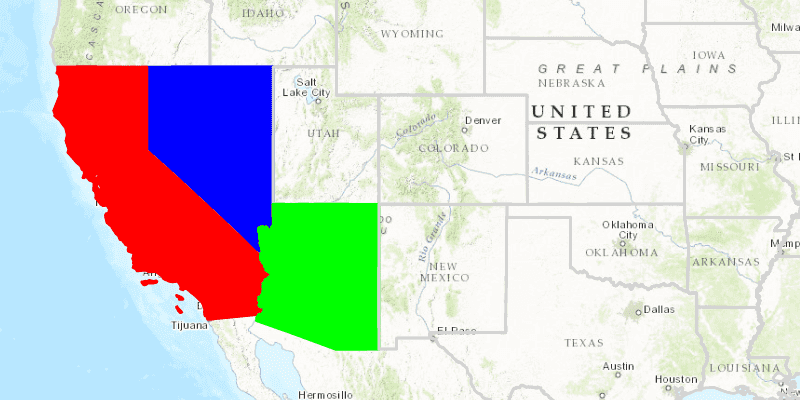Render features in a layer using a distinct symbol for each unique attribute value.

Use case
A unique value renderer allows you to symbolize features in a layer based on one or more matching attributes. This is typically done by using unique colors, fill styles, or images to represent features with equal values in a string field. A unique value renderer could be used to show different types of trees on a vegetation map by using a symbols corresponding to matching name attributes.
How to use the sample
The map with the symbolized feature layer will be shown automatically when the sample loads.
How it works
- Define a
SimpleFillSymbolfor each type of feature. - Apply the
SimpleFillSymbolto polygon features, which is the type of feature contained by thisServiceFeatureTable. - Create separate
UniqueValueobjects which define the values in the renderer field and the symbol used to render matching features. - Create a default symbol to render all features that do not match any of the
UniqueValueobjects defined.
Relevant API
- FeatureLayer
- ServiceFeatureTable
- SimpleFillSymbol
- SimpleLineSymbol
- UniqueValue
- UniqueValueRenderer
Additional information
Using the UniqueValueRenderer, separate symbols can be used to display features that have a specific value for a given field. In this case, the field is subregions of the USA. While multiple fields can be used, this sample only uses one.
About the data
The map shows U.S. states symbolized by subregion. Symbols are defined for Pacific, Mountain, and West South Central states. All other features are symbolized with the default symbol.
Tags
draw, renderer, symbol, symbology, values
Sample Code
/*
* Copyright 2017 Esri.
*
* Licensed under the Apache License, Version 2.0 (the "License"); you may not
* use this file except in compliance with the License. You may obtain a copy of
* the License at
*
* http://www.apache.org/licenses/LICENSE-2.0
*
* Unless required by applicable law or agreed to in writing, software
* distributed under the License is distributed on an "AS IS" BASIS, WITHOUT
* WARRANTIES OR CONDITIONS OF ANY KIND, either express or implied. See the
* License for the specific language governing permissions and limitations under
* the License.
*/
package com.esri.samples.unique_value_renderer;
import java.util.ArrayList;
import java.util.List;
import javafx.application.Application;
import javafx.scene.Scene;
import javafx.scene.layout.StackPane;
import javafx.stage.Stage;
import com.esri.arcgisruntime.ArcGISRuntimeEnvironment;
import com.esri.arcgisruntime.data.ServiceFeatureTable;
import com.esri.arcgisruntime.geometry.Envelope;
import com.esri.arcgisruntime.geometry.SpatialReferences;
import com.esri.arcgisruntime.layers.FeatureLayer;
import com.esri.arcgisruntime.mapping.ArcGISMap;
import com.esri.arcgisruntime.mapping.BasemapStyle;
import com.esri.arcgisruntime.mapping.Viewpoint;
import com.esri.arcgisruntime.mapping.view.MapView;
import com.esri.arcgisruntime.symbology.SimpleFillSymbol;
import com.esri.arcgisruntime.symbology.SimpleLineSymbol;
import com.esri.arcgisruntime.symbology.UniqueValueRenderer;
import com.esri.arcgisruntime.symbology.UniqueValueRenderer.UniqueValue;
public class UniqueValueRendererSample extends Application {
private MapView mapView;
// colors for symbols
private static final int GRAY = 0xFFD3D3D3;
private static final int RED = 0xFFFF0000;
private static final int GREEN = 0xFF00FF00;
private static final int BLUE = 0xFF0000FF;
@Override
public void start(Stage stage) {
try {
// create stack pane and application scene
StackPane stackPane = new StackPane();
Scene scene = new Scene(stackPane);
// set title, size, and add scene to stage
stage.setTitle("Unique Value Renderer Sample");
stage.setWidth(800);
stage.setHeight(700);
stage.setScene(scene);
stage.show();
// authentication with an API key or named user is required to access basemaps and other location services
String yourAPIKey = System.getProperty("apiKey");
ArcGISRuntimeEnvironment.setApiKey(yourAPIKey);
// create a map with the topographic basemap style
final ArcGISMap map = new ArcGISMap(BasemapStyle.ARCGIS_TOPOGRAPHIC);
// create a map view and set the map to it
mapView = new MapView();
mapView.setMap(map);
// set a viewpoint on the map view
mapView.setViewpoint(new Viewpoint(new Envelope(-13893029.0, 3573174.0, -12038972.0, 5309823.0,
SpatialReferences.getWebMercator())));
// create service feature table
String sampleServiceUrl = "https://sampleserver6.arcgisonline.com/arcgis/rest/services/Census/MapServer/3";
ServiceFeatureTable serviceFeatureTable = new ServiceFeatureTable(sampleServiceUrl);
// create the feature layer using the service feature table
final FeatureLayer featureLayer = new FeatureLayer(serviceFeatureTable);
// override the feature layer renderer with a new unique value renderer
UniqueValueRenderer uniqueValueRenderer = new UniqueValueRenderer();
// field name is a key, in a key/value pair, of a feature's attributes
// can be a list but only looking for one in this case
uniqueValueRenderer.getFieldNames().add("STATE_ABBR");
// create the symbols to be used in the renderer
SimpleFillSymbol defaultFillSymbol = new SimpleFillSymbol(SimpleFillSymbol.Style.NULL, 0x00000000,
new SimpleLineSymbol(SimpleLineSymbol.Style.SOLID, GRAY, 2));
SimpleFillSymbol californiaFillSymbol = new SimpleFillSymbol(SimpleFillSymbol.Style.SOLID, RED,
new SimpleLineSymbol(SimpleLineSymbol.Style.SOLID, RED, 2));
SimpleFillSymbol arizonaFillSymbol = new SimpleFillSymbol(SimpleFillSymbol.Style.SOLID, GREEN,
new SimpleLineSymbol(SimpleLineSymbol.Style.SOLID, GREEN, 2));
SimpleFillSymbol nevadaFillSymbol = new SimpleFillSymbol(SimpleFillSymbol.Style.SOLID, BLUE, new SimpleLineSymbol(
SimpleLineSymbol.Style.SOLID, BLUE, 2));
// set the default symbol
uniqueValueRenderer.setDefaultSymbol(defaultFillSymbol);
uniqueValueRenderer.setDefaultLabel("Other");
// set value for California, Arizona, and Nevada
List<Object> californiaValue = new ArrayList<>();
californiaValue.add("CA");
uniqueValueRenderer.getUniqueValues().add(new UniqueValue("State of California", "California",
californiaFillSymbol, californiaValue));
List<Object> arizonaValue = new ArrayList<>();
arizonaValue.add("AZ");
uniqueValueRenderer.getUniqueValues().add(new UniqueValue("State of Arizona", "Arizona", arizonaFillSymbol,
arizonaValue));
List<Object> nevadaValue = new ArrayList<>();
nevadaValue.add("NV");
uniqueValueRenderer.getUniqueValues().add(new UniqueValue("State of Nevada", "Nevada", nevadaFillSymbol,
nevadaValue));
// set the renderer on the feature layer
featureLayer.setRenderer(uniqueValueRenderer);
// add the feature layer to the map's operational layers
map.getOperationalLayers().add(featureLayer);
// add the map view and control panel to stack pane
stackPane.getChildren().add(mapView);
} catch (Exception e) {
e.printStackTrace();
}
}
/**
* Stops and releases all resources used in application.
*/
@Override
public void stop() {
// release resources when the application closes
if (mapView != null) {
mapView.dispose();
}
}
/**
* Opens and runs application.
*
* @param args arguments passed to this application
*/
public static void main(String[] args) {
Application.launch(args);
}
}